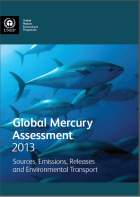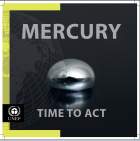The fifth and final session of the International Negotiating Committee to prepare a global legally binding instrument on mercury (INC5) has begun yesterday and will end January 18 in Geneva, Switzerland,
Background:Mercury is recognized as a chemical of global concern due to its long-range transport in the atmosphere, its persistence in the environment, its ability to bioaccumulate in ecosystems and its significant negative effect on human health and the environment. Mercury can produce a range of adverse human health effects, including permanent damage to the nervous system, in particular the developing nervous system.
UNEP has been working to address mercury issues since 2003. In February 2009, the Governing Council of UNEP agreed on the need to develop a global legally binding instrument on mercury. The work to prepare this instrument is undertaken by an intergovernmental negotiating committee supported by the Chemicals Branch of the UNEP Division of Technology, Industry and Economics as secretariat.
UNEP Mercury Treaty: Fifth session
Established in 2009 by the United Nations Environmental Programme (UNEP) and ministers of the environment from over 140 countries, the committee has the goal of developing an international treaty to curb mercury emissions and discharges in order to reduce this threat to human health and the environment. The committee plans to have all negotiations completed prior to the 27th session of the UNEP Governing Council/Global Ministerial Environment Forum taking place this February in Kenya, and to ratify the treaty later this year in Japan.
UNEP published two new reports in the run-up to the INC5 meeting:

 Global Mercury Assessment 2013
Global Mercury Assessment 2013Sources, emissions, releases, and environmental transport
This report presents sources of mercury emissions to air and water. It presents estimates of anthropogenic emissions to air from various sources based on data from 2010 and estimates for releases to aquatic environment. The report also presents the latest information on atmospheric and aquatic chemistry , fate and transport. It is an overall summary report for the policy makers based on a technical background report.

 Mercury: Time to Act
Mercury: Time to ActThis report speaks directly to governments involved in development of the global treaty on mercury. It presents updates from the UNEP Global Mercury Assessment 2013 in short and punchy facts and figures backed by compelling graphics that provide governments and civil society with the rationale and the imperative to act on this notorious pollutant.
Source: Adapted from UNEP
 Related information
Related information UNEP: Reducing Risk from Mercury
UNEP: Reducing Risk from Mercury Related EVISA Resources
Related EVISA Resources Link database: Mercury exposure through the diet
Link database: Mercury exposure through the diet Link database: Environmental cycling of mercury
Link database: Environmental cycling of mercury Link database: Toxicity of Organo-mercury compounds
Link database: Toxicity of Organo-mercury compounds Link database: Research projects related to organo-mercury compounds
Link database: Research projects related to organo-mercury compounds Related EVISA News
Related EVISA News
 December 18, 2012: Pediatricians Argue to Keep Thimerosal in Some Vaccines
December 18, 2012: Pediatricians Argue to Keep Thimerosal in Some Vaccines
 December 9, 2012: Mercury in fish more dangerous than previously believed; Scientists urge for effective treaty ahead of UN talks
December 9, 2012: Mercury in fish more dangerous than previously believed; Scientists urge for effective treaty ahead of UN talks
 October 12, 2012: Prenatal mercury intake linked to ADHD
October 12, 2012: Prenatal mercury intake linked to ADHD July 15, 2012: World Health Organization Fails In Its Effort To Defend Mercury In Vaccines Before United Nations
July 15, 2012: World Health Organization Fails In Its Effort To Defend Mercury In Vaccines Before United Nations
 October 28, 2011: WHO worries mercury treaty could affect costs and availability of vaccines
October 28, 2011: WHO worries mercury treaty could affect costs and availability of vaccines  August 8, 2011: UNEP Global Mercury Treaty May Include Ban on Mercury in Medicine
August 8, 2011: UNEP Global Mercury Treaty May Include Ban on Mercury in Medicine June 19, 2011: Committee for Socio-economic Analysis agrees on
two draft opinions on restriction proposals for mercury compounds under
REACH
June 19, 2011: Committee for Socio-economic Analysis agrees on
two draft opinions on restriction proposals for mercury compounds under
REACH
last time modified: January 20, 2025